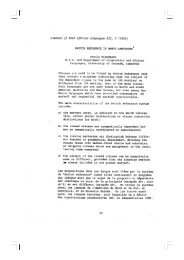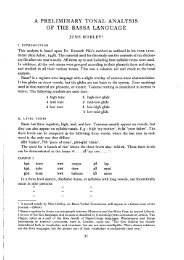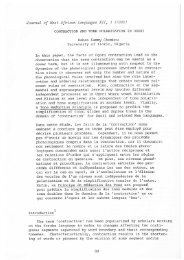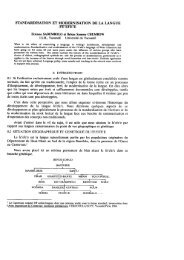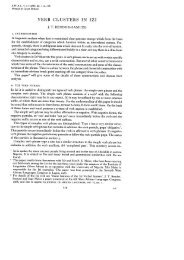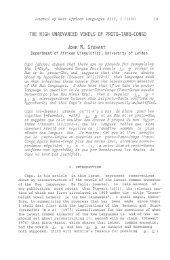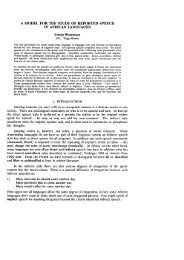The floating low tone in Bantu - Journal of West African Languages
The floating low tone in Bantu - Journal of West African Languages
The floating low tone in Bantu - Journal of West African Languages
You also want an ePaper? Increase the reach of your titles
YUMPU automatically turns print PDFs into web optimized ePapers that Google loves.
6 <strong>Journal</strong> <strong>of</strong> <strong>West</strong> <strong>African</strong> <strong>Languages</strong> XXXI.1 (2004)<br />
1.2 RELEVANT PHONOLOGICAL RULES<br />
Two contiguous syllabic peaks across morpheme boundaries are not permitted <strong>in</strong><br />
this language. As a result, when two vowels are juxtaposed one <strong>of</strong> them (the second)<br />
deletes. <strong>The</strong> rule <strong>in</strong> 2a will capture this.<br />
(2) a. V Ø/ V+<br />
If one <strong>of</strong> the two syllabic peaks is a syllabic nasal, the nasal desyllabifies as stipulated<br />
by rule 2b.<br />
(2) b. N N / V<br />
[+syll] [-syll]<br />
<strong>The</strong>se two rules are very crucial for the discussions <strong>in</strong> this paper<br />
3. HIGH TONE SPREAD<br />
In Bafut, a high <strong>tone</strong> always spreads onto an object noun, which carries a <strong>low</strong><br />
<strong>tone</strong> <strong>in</strong> isolation. Normally, this results <strong>in</strong> the fol<strong>low</strong><strong>in</strong>g TBU be<strong>in</strong>g high <strong>tone</strong>d, with<br />
no evidence <strong>of</strong> there hav<strong>in</strong>g ever been a <strong>low</strong> <strong>tone</strong> present. <strong>The</strong> data <strong>in</strong> 3a illustrate this.<br />
(<strong>The</strong> constructions here are <strong>in</strong> the imperative).<br />
(3) a. (i) /fa + bloo/ [fabloo] give husbands<br />
(ii) /fa + nb/ [fanb] give a pumpk<strong>in</strong><br />
(iii) / fa + mluu/ [famluu] give some w<strong>in</strong>e<br />
(iv) / fa + ft/ [faft] give a calabash<br />
<strong>The</strong> nouns that have been collocated with the verb [fa] “give” have been<br />
selected from different classes 5 . 3a (i) is from class 2, 3a(ii) from class 5, 3a(iii) from<br />
class 6 and 3a (iv) from class 19. One th<strong>in</strong>g is clear <strong>in</strong> the data <strong>in</strong> 3a – that a spread<strong>in</strong>g<br />
high <strong>tone</strong> can lead to a level high <strong>tone</strong> on the <strong>in</strong>itial syllable <strong>of</strong> the object noun. This<br />
HTS rule can be formulated as shown <strong>in</strong> 3b 6 be<strong>low</strong>.<br />
5 We have paid attention here only to the noun classes with a CV- nom<strong>in</strong>al prefix because they show high<br />
<strong>tone</strong> spread dist<strong>in</strong>ctively. If we were to take class 3 or 7 nouns, the <strong>in</strong>itial Vowel or syllabic nasal will have<br />
to be deleted or desyllabified respectively (Rule 2) and one will not be able to notice the HTS.<br />
6 <strong>The</strong> f<strong>in</strong>al fall<strong>in</strong>g <strong>tone</strong> <strong>in</strong> the surface representation (SR) is a result <strong>of</strong> an <strong>in</strong>tonational <strong>low</strong> <strong>tone</strong> that surfaces<br />
at the end <strong>of</strong> any phrase. Consider the fol<strong>low</strong><strong>in</strong>g as example:<br />
fa ‘ive’ famu ‘ive a child’ famuwa ‘ive the child’<br />
<strong>The</strong> phrasal <strong>tone</strong> is always realized on the last syllable <strong>of</strong> the phrase <strong>in</strong> this language. This is why most<br />
utterances <strong>in</strong> this language either end <strong>in</strong> a fall<strong>in</strong>g <strong>tone</strong> or a <strong>low</strong> <strong>tone</strong>.



